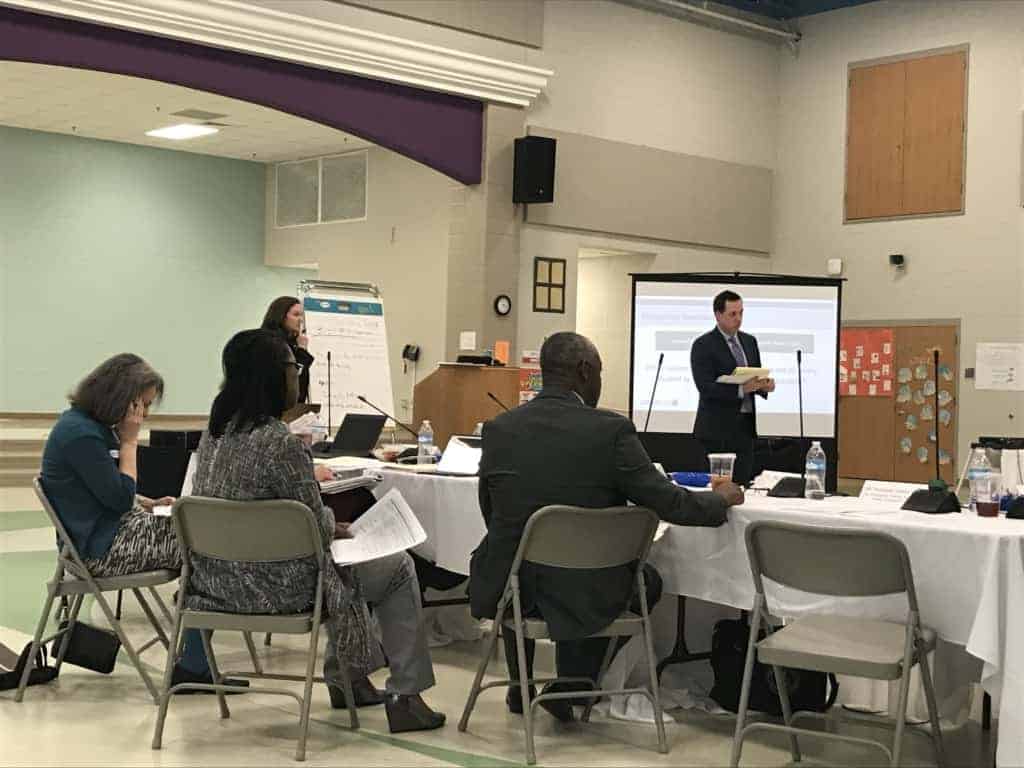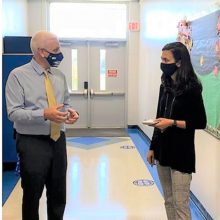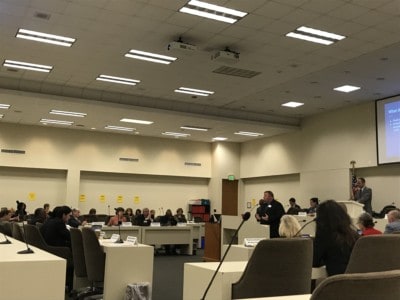On Tuesday, the Governor’s Commission on Access to Sound, Basic Education held their second meeting at George C. Simkins, Jr. Elementary School in Greensboro. The commission, created by Governor Cooper’s executive order in November, has been tasked with focusing on issues highlighted in the decades-long Leandro case, including staffing schools with well-trained teachers and principals, and identifying the resources necessary to ensure all children have an equal opportunity to obtain a sound basic education.
The 18-member commission is comprised of experts from various fields and chaired by Brad Wilson, former CEO of Blue Cross Blue Shield of North Carolina.
Commission members heard from Adam Levinson, chief financial officer for the North Carolina Department of Public Instruction, on the system of allotments that funds public schools across the state. Levinson also touched on the system of special allotments that are designed to address economic disadvantage.
According to Levinson, the allotment system provides a mechanism for allocating what funds each school district receives using a standardized formula. This system provides stability across fiscal years, allowing school administrators to better plan for hiring decisions based on the anticipated number of students they will have in August.
Position allotments, determined by the number of students that are expected to enroll at a school in a given year, provide the school district with a guarantee of funding for a 10-month teacher position regardless of expertise. This levels the playing field between districts, allowing them to all have the same purchasing power regardless of wealth.
“Part of the position allotment design is to promote that wherever you are, you go after the best, most experienced teacher in the state,” said Levinson. “The state doesn’t want county X over here without local resources, compared to county Y, to be at a disadvantage going after the higher paid, more experienced teacher.”
Levinson then gave an overview of the three supplemental allotments that are designed to address economic disadvantage among school districts: low-wealth supplemental funding, disadvantaged student supplemental funding, and at-risk supplemental funding.
Throughout Levinson’s presentation, multiple commission members brought up one key question: does the current system of state allotments provide sufficient funding for access to a sound basic education for every student in North Carolina?
The commission then heard from a three-person panel comprised of finance officers from three districts across the state — Onslow County School System, Cabarrus County Schools, and Sampson County Schools. Offering a perspective on how the allotment system plays out on a local level, the panel offered insight into what they believe is and isn’t working within the school funding structure.
Jeff Hollamon, finance officer of the Onslow County School System, spoke highly of the positional allotment systems, saying the system helps him plan hiring decisions for the upcoming year and ensures that positions stay adequately funded regardless of mandated changes to salaries or benefits.
Wilson then asked the panel what they would change about the allotment system to improve it, if anything at all. The finance officers identified issues such as a lack of adequate funding across all allotments, outdated allotment formulas, and a lack of flexibility in how allotments can be used.
“The overlying issue and challenge with the current allotment process is adequacy,” said Hollamon. “If you don’t have enough funds overall, even if you have complete flexibility so you can move funds around, across the board you have inadequate funding to provide what your students need.”
Hollamon then identified another issue: outdated allotment formulas that don’t meet the needs of today’s students. According to Hollamon, the state has not revisited allotment formulas to account for emerging areas of need, such as the expansion of technology, school safety and security, and student behavioral support.
Stephen Britt, finance officer at Sampson County Schools, discussed the barriers that a lack of flexibility in allotments create at a local level.
“Our funding system has moved more and more towards silos. Each allotment is in it’s own silo and you can’t move between those two silos,” said Britt. “It all comes back to a flexibility thing. All 115 districts in the state have their own unique needs.”
Offering an example of one such flexibility issue, Britt explained that funding designated for academically or intellectually gifted (AIG) students could strictly be used for AIG students. While this may sound great on the surface, he explained, Britt was able to fill a vacancy for AIG personnel with a teacher that didn’t cost as much as the allotted funds. However, he was unable to transfer those remaining AIG funds to supplement an underfunded area where the needs of students had not been met — in this case, the exceptional children program.
The commission then received a presentation from consultants with WestEd, a nonpartisan, nonprofit research, development, and service agency appointed by Judge David Lee to serve as an independent consultant to the court in the Leandro lawsuit.
After a brief review of the Leandro tenets, WestEd consultant Jason Willis presented on costing methodologies and discussed both input-based and output-based considerations that inform the creation of a school funding model.
According to Willis’ presentation, the first step for any cost and resource analysis is to determine the desired outcome for students. To do this, Willis broke commission members up into multiple small groups to facilitate discussion around clearly defining what it means to provide a “sound basic education.” They were tasked with discussing the following questions:
- What outcomes should North Carolina set for every student to achieve a sound basic education?
- What are the measures available to know that each student has been provided a sound basic education?
- What are the different types of resources needed to ensure that each child can meet these goals? How do these inputs differ by student and district?


“We need to have a courageous conversation about what sound basic education means and soaring beyond that,” said Leigh Kokenes, the school psychologist representative on the commission. “We want great teachers, we want kids to become critical thinkers, practice kindness and have a global sense of the world, but we also want them to have a sense of community.”
Leslie Winner, an at-large representative to the commission, mentioned key aspects of today’s educational landscape that differ from 1997 when the original Leandro ruling was passed, including: an increasingly diverse student population, new technology platforms, media literacy, and social and emotional skills.
According to Wilson, the commission will split into subcommittees during their June meeting and work on studying individual topics until the commission meets again in September. The commission will also leverage expertise from beyond North Carolina on the issue of school finance via webinars.
“This is the beginning of an ongoing conversation not only for this group but for the state as a whole as we look to try and figure out how to keep the constitutional obligation of Leandro,” said Geoff Coltrane, Cooper’s senior education advisor.
Editor’s Note: Judge David Lee is the father of EducationNC Managing Editor and Content Director Laura Lee. Mebane Rash edited this article.



